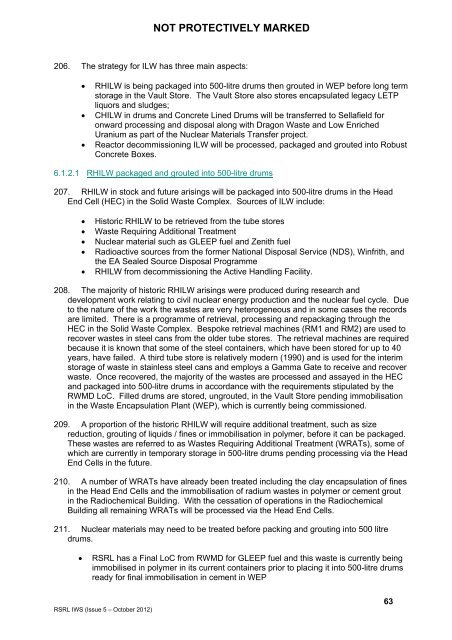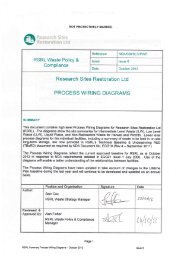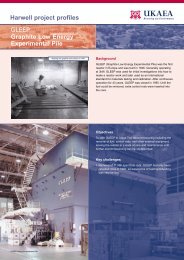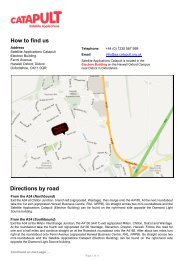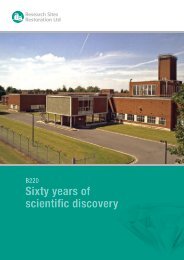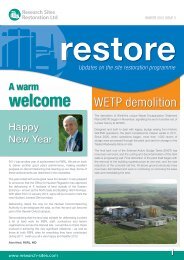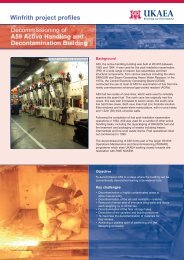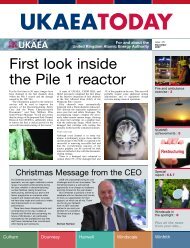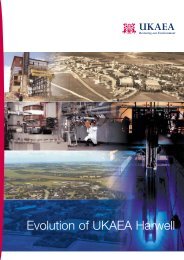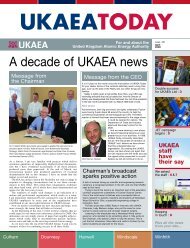RSRL Integrated Waste Strategy - Issue 5- Oct 2012.pdf
RSRL Integrated Waste Strategy - Issue 5- Oct 2012.pdf
RSRL Integrated Waste Strategy - Issue 5- Oct 2012.pdf
Create successful ePaper yourself
Turn your PDF publications into a flip-book with our unique Google optimized e-Paper software.
NOT PROTECTIVELY MARKED206. The strategy for ILW has three main aspects:• RHILW is being packaged into 500-litre drums then grouted in WEP before long termstorage in the Vault Store. The Vault Store also stores encapsulated legacy LETPliquors and sludges;• CHILW in drums and Concrete Lined Drums will be transferred to Sellafield foronward processing and disposal along with Dragon <strong>Waste</strong> and Low EnrichedUranium as part of the Nuclear Materials Transfer project.• Reactor decommissioning ILW will be processed, packaged and grouted into RobustConcrete Boxes.6.1.2.1 RHILW packaged and grouted into 500-litre drums207. RHILW in stock and future arisings will be packaged into 500-litre drums in the HeadEnd Cell (HEC) in the Solid <strong>Waste</strong> Complex. Sources of ILW include:• Historic RHILW to be retrieved from the tube stores• <strong>Waste</strong> Requiring Additional Treatment• Nuclear material such as GLEEP fuel and Zenith fuel• Radioactive sources from the former National Disposal Service (NDS), Winfrith, andthe EA Sealed Source Disposal Programme• RHILW from decommissioning the Active Handling Facility.208. The majority of historic RHILW arisings were produced during research anddevelopment work relating to civil nuclear energy production and the nuclear fuel cycle. Dueto the nature of the work the wastes are very heterogeneous and in some cases the recordsare limited. There is a programme of retrieval, processing and repackaging through theHEC in the Solid <strong>Waste</strong> Complex. Bespoke retrieval machines (RM1 and RM2) are used torecover wastes in steel cans from the older tube stores. The retrieval machines are requiredbecause it is known that some of the steel containers, which have been stored for up to 40years, have failed. A third tube store is relatively modern (1990) and is used for the interimstorage of waste in stainless steel cans and employs a Gamma Gate to receive and recoverwaste. Once recovered, the majority of the wastes are processed and assayed in the HECand packaged into 500-litre drums in accordance with the requirements stipulated by theRWMD LoC. Filled drums are stored, ungrouted, in the Vault Store pending immobilisationin the <strong>Waste</strong> Encapsulation Plant (WEP), which is currently being commissioned.209. A proportion of the historic RHILW will require additional treatment, such as sizereduction, grouting of liquids / fines or immobilisation in polymer, before it can be packaged.These wastes are referred to as <strong>Waste</strong>s Requiring Additional Treatment (WRATs), some ofwhich are currently in temporary storage in 500-litre drums pending processing via the HeadEnd Cells in the future.210. A number of WRATs have already been treated including the clay encapsulation of finesin the Head End Cells and the immobilisation of radium wastes in polymer or cement groutin the Radiochemical Building. With the cessation of operations in the RadiochemicalBuilding all remaining WRATs will be processed via the Head End Cells.211. Nuclear materials may need to be treated before packing and grouting into 500 litredrums.• <strong>RSRL</strong> has a Final LoC from RWMD for GLEEP fuel and this waste is currently beingimmobilised in polymer in its current containers prior to placing it into 500-litre drumsready for final immobilisation in cement in WEP<strong>RSRL</strong> IWS (<strong>Issue</strong> 5 – <strong>Oct</strong>ober 2012)63


